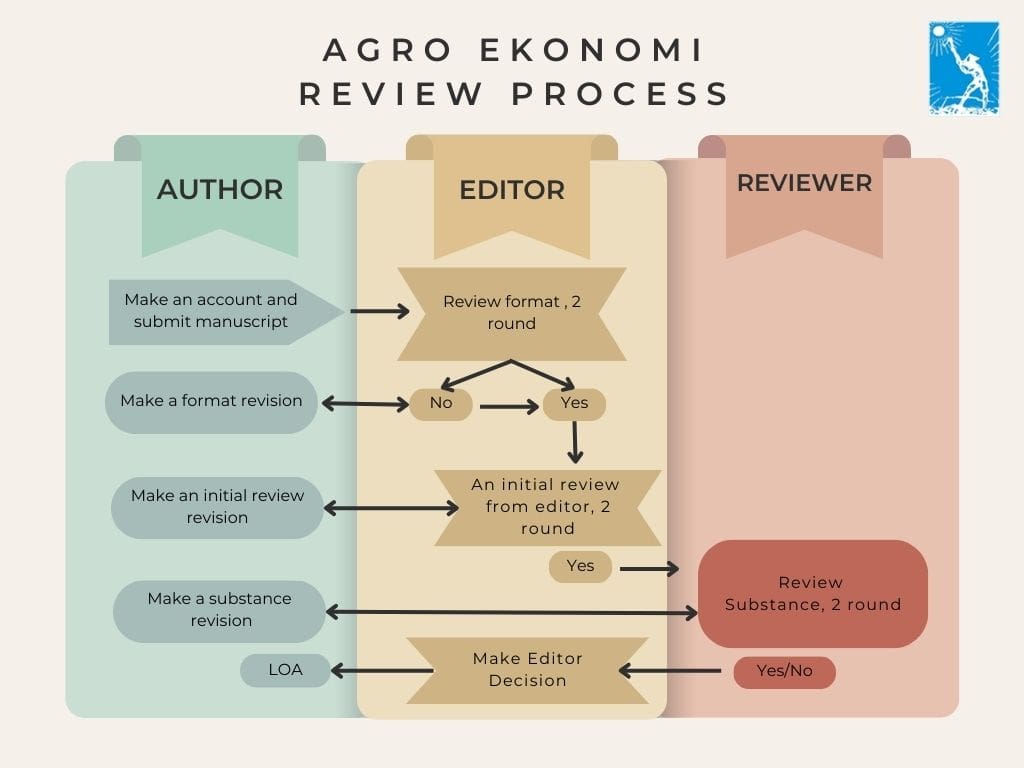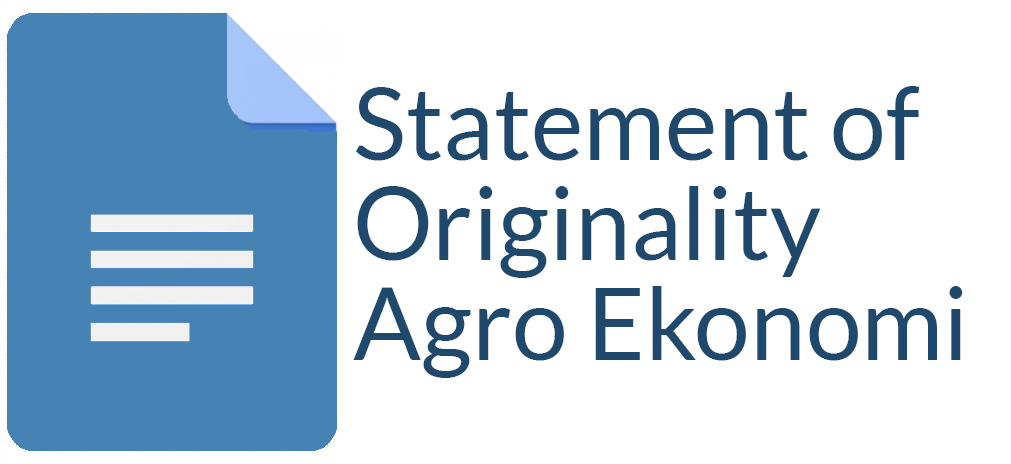The Evaluation of Several Alternative Policies’ Impact on The Mandarin (Citrus Reticulata) Industry in Indonesia: A System Dynamics Analysis
Lyli mufidah(1*), Fatimah Mohamed Arshad(2), Shaufique Sidique(3), Agus Sugiyatno(4), Abdulla Ibragimov(5)
(1) Indonesian Citrus and Subtropical Fruits Research Institute (ICSFRI)
(2) Institute of Agricultural and Food Policy Studies-UPM
(3) Institute of Agricultural and Food Policy Studies-UPM
(4) Indonesian Citrus and Subtropical Fruits Research Institute (ICSFRI)
(5) Institute of Agricultural and Food Policy Studies-UPM
(*) Corresponding Author
Abstract
Keywords
Full Text:
PDFReferences
Abdulla, I., Arshad, F. M., Bala, B. K., Noh, K. M., & Tasrif, M. (2014). Impact of cpo export duties on Malaysian palm oil industry. American Journal of Applied Sciences, 11(8), 1301–1309. https://doi.org/10.3844/ajassp.2014.1301.1309
Adipraja, P. F. E., & Sulistyo, D. A. (2018). Pemodelan Sistem Dinamik untuk Prediksi Intensitas Hujan Harian di Kota Malang. Jurnal Ilmiah Teknologi Informasi Asia, 12(2), 137. https://doi.org/10.32815/jitika.v12i2.272
Arsanti, I. W., Marbun, F., & Micharam, I. (2015). Upaya peningkatan daya saing komoditas jeruk melalui pendekatan system dynamic, studi kasus: sentra produksi Kabupaten Karo dan sentra konsumsi DKI Jakarta. In Kebijakan pencapaian swasembada dan swasembada berkelanjutan lima komoditas utama pertanian melalui pendekatan sistem dinamik (pp. 165–180).
Bassanezi, R. B., Montesino, L. H., Gasparoto, M. C. G., Filho, A. B., & Amorim, L. (2011). Yield loss caused by huanglongbing in different sweet orange cultivars in São Paulo, Brazil. European Journal of Plant Pathology, 130(4), 577–586. https://doi.org/10.1007/s10658-011-9779-1
Duflo, E; M, Kremer; J, R. (2011). Nudging farmers to use fertilizer: “Theory and Experimental Evidence from Kenya.” American Economic Review, 101(6), 2350–2390.
Ernawati, Lilis; Suryani, E. (2013). Analisis faktor produktivitas gula nasional dan pengaruhnya terhadap harga gula domestik dan permintaan gula impor dengan menggunakan sistem dinamik. Jurnal Teknik Pomits, 1(1), 1–7.
Ferreira, J. O., Batalha, M. O., & Domingos, J. C. (2016). Integrated planning model for citrus agribusiness system using systems dynamics. Computers and Electronics in Agriculture, 126, 1–11. https://doi.org/10.1016/j.compag.2016.04.029
Hidayatno, A., Sutrisno, A., Zagloel, Y. M., & Purwanto, W. W. (2011). System Dynamics Sustainability Model of Palm-Oil Based Biodiesel Production Chain in Indonesia. International Journal of Engineering & Technology, 11(June), 1–6. https://doi.org/10.3389/fmicb.2016.00933
L, Fu Jia; D., Suo Cheng; L, F. (2012). A system dynamics model for analyzing the eco-agriculture system with policy recommendations. Ecological Modelling, 227, 34–45.
Marks, S. V. (2012). Indonesian Horticultural Imports and Policy Responses-An Assessment. Washington, D.C, USA.
Meitayani, N. P. S., Adiartayasa, W., & Wijaya, I. N. (2014). Deteksi Penyakit Citrus Vein Phloem Degeneration (CVPD) dengan Teknik Polymerase Chain Reaction (PCR) pada Tanaman Jeruk di Bali. E-Jurnal Agroekoteknologi Tropika, 3(2), 70–79.
Nurhadi. (2015). PENYAKIT HUANGLONGBING TANAMAN JERUK ( Candidatus Liberibacter asiaticus ): ANCAMAN DAN STRATEGI PENGENDALIAN Huanglongbing Disease ( Candidatus Liberibacter asiaticus ) on Citrus : Threats and Control Strategy. Pengembangan Inovasi Pertanian, 8(1), 21–32.
P, Kaufmann; S, Stagl; D.W, F. (2009). Simulating the difusion of organic farming practices in two new EU Member States. Ecological Economics, 68, 2580–2593.
Pan, Y., Smith, S. C., & Sulaiman, M. (2018). Agricultural extension and technology adoption for food security: Evidence from Uganda. American Journal of Agricultural Economics, 100(4), 1012–1031. https://doi.org/10.1093/ajae/aay012
Pardey, P. G., Alston, J. M., & Kang, C. C. (2012). Agricultural Production , Productivity and R & D over the Past Half Century : An Emerging New World Order. In Conference of International Association of Agricultural Economists (p. 48).
Qudrat-Ullah, H. (2012). On the validation of system dynamics type simulation models. Telecommunication Systems, 51(2–3), 159–166. https://doi.org/10.1007/s11235-011-9425-4
Rozman, Č., Kljajić, M., & Škraba, A. (2015). System dynamics model for conversion to organic farming. Journal of Siberian Federal University - Mathematics and Physics, 8(1), 67–74. https://doi.org/10.17516/1997-1397-2015-8-1-64-74
Spreen, T. H., Baldwin, J. P., & Futch, S. H. (2014). An economic assessment of the impact of Huanglongbing on citrus tree plantings in Florida. HortScience, 49(8), 1052–1055.
Sterman, J. D. (2004). Business Dynamics : Systems Thinking and Modeling for a Complex World. McGraw-Hill (Vol. 34). USA. https://doi.org/10.1108/13673270210417646
Teimoury, E., Nedaei, H., Ansari, S., & Sabbaghi, M. (2013). A multi-objective analysis for import quota policy making in a perishable fruit and vegetable supply chain: A system dynamics approach. Computers and Electronics in Agriculture, 93, 37–45. https://doi.org/10.1016/j.compag.2013.01.010
Thohirah Lee Abdullah Kamaruzaman Sijam and Siti Nor Akmar, H. S., & Abdullah. (2009). Control of Huanglongbing (HLB) disease with reference to its occurrence in Malaysia. African Journal of Biotechnology, 8(17), 4007–4015. https://doi.org/10.5897/AJB09.678
Udry, C. (2010). The economics of agriculture in Africa: notes toward a research program. African Journal of Agricultural and Resource Economics, 5(1), 284–299.
Wossen, T., Abdoulaye, T., Alene, A., Haile, M. G., Feleke, S., Olanrewaju, A., & Manyong, V. (2017). Impacts of extension access and cooperative membership on technology adoption and household welfare. Journal of Rural Studies, 54, 223–233. https://doi.org/10.1016/j.jrurstud.2017.06.022
Yunna, W., Kaifeng, C., Yisheng, Y., & Tiantian, F. (2015). A system dynamics analysis of technology, cost and policy that affect the market competition of shale gas in China. Renewable and Sustainable Energy Reviews, 45, 235–243. https://doi.org/10.1016/j.rser.2015.01.060Article Metrics
Refbacks
- There are currently no refbacks.
Copyright (c) 2018 Agro Ekonomi

This work is licensed under a Creative Commons Attribution-ShareAlike 4.0 International License.
View My Stats











